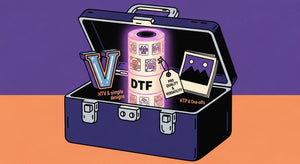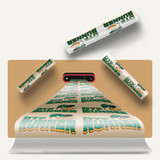Table of Contents
When deciding between DTF heat transfers and sublimation, it is essential to understand the nuances of each method. This guide will help you determine the advantages and disadvantages of DTF printing and sublimation to help you determine which process best suits your needs.
Be it as an experienced printer or someone who has just entered the beautiful world of DDT heat transfers; this comparison is going to get you the information you need to decide. When you are done doing your research, you will have a better idea about the type of printing you may want to do. With this article, we want to help in your decision-making process.

What Are DTF Heat Transfers?
DTF or direct-to-film heat transfers is a process whereby designs are printed onto a special kind of film then ink on the film transfers onto a garment under heat and pressure. This was quickly taken up by many as it was versatile and offered bright details in prints on a wide material range.
Advantages of DTF Heat Transfers
- Versatility: DTF heat transfers work on various fabrics, including cotton, polyester, blends, and even dark-colored materials. This is an ideal choice for those who want to print on different types of garments.
- Vibrant Colors: The DTF process allows for high color saturation, resulting in bright and vivid designs that stand out. The colors are rich and capture intricate details, making your designs stand out.
- Durability: Prints created with DTF heat transfers are long-lasting and withstand multiple washes without significant fading or cracking. The prints remain intact and retain their quality over time.
- Ease of Use: The process is straightforward, and becomes accessible even for beginners. Even with minimal training, you can start producing high-quality prints quickly and efficiently.
Disadvantages of DTF Heat Transfers
- Special Equipment Needed: To default to DTF printing, a certain kind of printer and special film with adhesive powder are required. This can run into quite an investment. This initial startup cost can be a prohibiting factor to many, mainly small businesses or a hobbyist.
- Setup Complexity: More complex setup compared to other methods. Requires tuning for high-quality printing. For the best results, it requires well-calibrated and properly maintained ones.
Of course, DTF heat transfer gives versatility and durability to the user. It offers a broad reach of fabric compatibility and results in vibrant, long-lasting prints. Run into dark garments or non-polyester materials with your designs and still be sharp and vibrant after repeated washes—this is what DTF heat transfer can do. This makes DTF appropriate for businesses looking to diversify their products for customers.
What is Sublimation Printing?
Sublimation printing is where dye is transferred onto a material using heat. Not like DTF heat transfers, the process of sublimation changes the state of solid dye straight into gas, bypassing the liquid state, and subsequently penetrates into the fabric to form a permanent bond.
Advantages of Sublimation Printing
- High Quality and Detail: Sublimation produces sharp, detailed images with smooth transitions and vibrant colors. This method is ideal for producing high-resolution prints with complex designs and fine details.
- Permanent Prints: Because the dye becomes part of the fabric, sublimation prints do not crack, peel, or fade over time. The prints are embedded into the material, ensuring long life and durability.
- Soft Feel: The prints have a soft touch because the dye penetrates the fabric rather than sitting on top of it. This ensures that the garments are comfortable to wear without adding any texture to the print.
- Eco-Friendly: Sublimation uses water-based inks and generates minimal waste. If we compare it to other printing methods that use more harmful chemicals and produce more waste, this makes it an environmentally friendly option.

Disadvantages of Sublimation Printing
- Material Limitations: Sublimation only works on polyester fabrics or items that have a polyester coating. It will just not work with cotton or dark colored fabrics. The range of products that can be manufactured is limited.
- Initial Investment: Just like DTF, sublimation has a type it requires, and this is only possible to get along with a sublimation printer and heat press. These machines are costly, especially for newcomers.
- Color Limitations: Sublimation works best on white or light-colored materials since the inks applied are transparent and do not turn up so well against dark backgrounds. Admittedly, with a variety of colors or fabric types, the design possibilities can be somewhat limited.
In case you are interested in producing high-quality permanent prints onto polyester materials, sublimation printing will be the method used. Such prints are very bright, highly detailed, and soft to the touch—just perfect for sportswear, promotion materials, and above all, for single, personalized articles. Sublimation is also a very environment-friendly type of printing process. It uses water-based inks and produces minimal waste. This process would then fit best with those focusing on high-end products and environmental sustainability.
DTF Heat Transfers vs. Sublimation: Key Differences
- Material Compatibility: One of the key differences between DTF heat transfers and sublimation is the type of material they can be applied to. DTF is versatile and works on a variety of fabric types and colors. In contrast, sublimation is limited to polyester and light-colored substrates. DTF is a better option for those who need flexibility in their printing projects.
- Print Durability: The two techniques produce durable prints but arrive at this result differently. DTF prints lie on top of the fabric and are bonded with an adhesive that protects them against cracking and fading. In sublimation, dyes bond directly to fabric fibers to ensure that the print is going to last and resist wear-tear actions. Both methods ensure long-lasting results, but the approach is quite different.
- Color and Design: Both techniques perform excellent with color vibrancy and complex designs. Sublimation will offer you a better blend with gradients and is good for photographic images with all the colors. DTF does allow vibrant colors, but one might need a few more steps to get some fine effects, like especially on darker fabrics. Which of the two methods to choose totally depends on the specific needs of your project and the kind of design you are looking to forge.
Choosing Between DTF Heat Transfers and Sublimation
When choosing between DTF heat transfers and sublimation, consider the following factors:
- Material: What type of fabric or item are you printing on? If you need to print on cotton or dark fabrics, you should choose the DTF method. Sublimation offers superior quality in polyester and light-colored items. Evaluate your material needs before deciding on a printing method.
- Print Durability: It's a case of the two processes offering durable prints, but sublimation would do better in a situation where a soft feel and high resilience to wear are of the essence. You must consider the end-use of the printed items and the level of durability required.
- Cost and Equipment: Consider the budget and, in particular, the initial investment that each method requires. Since both DTF and sublimation will have you getting special equipment, be sure to consider long-term use and return on investment. You must also, therefore, consider the cost of supplies, maintenance, or even possible expansion of a printing business.
- Ease of Use: If you are new to printing, the DTF’s simple process may be more appealing. However, if you prioritize high-quality photographic prints, the complexity of sublimation can be beneficial. Consider the learning curve and the level of expertise required for each method.

Frequently Asked Questions
1. Can I use DTF heat transfers on cotton fabrics?
Yes, DTF heat transfers are compatible with various fabrics, including cotton, making them a versatile choice for many printing projects. This versatility allows for a wider range of applications compared to sublimation.
2. Is sublimation printing limited to light-colored garments?
Yes, sublimation works best on white or light-colored polyester fabrics. Because of the transparent nature of the inks, they do not show up well on dark backgrounds. This limitation should be taken into account when planning your designs and choosing your materials.
3. Which method is more cost-effective for a small business?
It all depends on what you need and how much you make. DTF may be more versatile for small businesses working with different types of fabric, and dye sublimation might serve better for high-volume printing of polyester material. Consider your business model, production needs, and budget before deciding.
4. Are DTF prints as durable as sublimation prints?
Both DTF and sublimation prints are quite durable. DTF prints are bonded with adhesive, making them resistant to cracking and fading, while sublimation dyes bond with the fabric fibers, providing longevity and resilience. Both methods provide long-lasting results, but the specific application and material will determine which is more suitable.
5. Which method offers better color vibrancy?
Both methods deliver vibrant colors, but sublimation generally provides superior gradient blending and photo quality on polyester fabrics. DTF also produces bright, vivid prints on dark fabrics with a proper set-up using good materials. The choice depends on what kind of design shall be produced and what kind of material will be used.
Follow this guide and bear these factors in mind to make an informed decision as to whether DTF heat transfers or sublimation will be the best for your printing. Each of these methods has different strengths that focus on different areas of your business to ensure quality prints that fill specific needs. We wish you the best of luck on this new, exciting journey.






